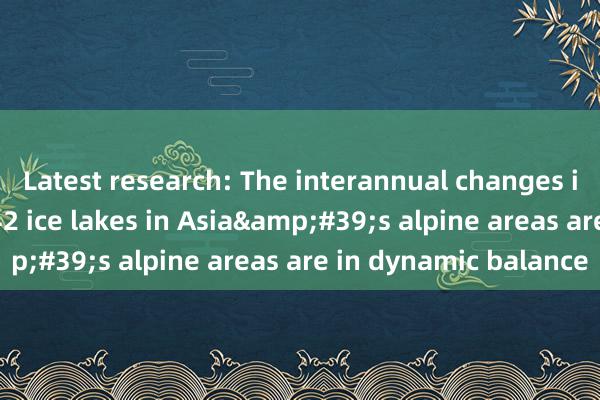
China News Service, Beijing, March 7 (Reporter Sun Zifa) Asian alpine areas have developed glaciers second only to Antarctic and Arctic scale. How does the water level of the ice lake change interannual? How to affect the environment and downstream areas?
The Tripolar Observation and Big Data Team of the Qinghai-Tibet Plateau Research Institute of the Chinese Academy of Sciences, together with Chinese and foreign partners, has completed the latest research on "Space Pattern and Change Rate of Ice Lake Water Level in Asian Alpine Areas" and shows that from 2019 to 2023, the interannual changes in the water level of 442 ice lakes in Asian Alpine Areas are in dynamic balance.
This important research in the field of alpine ice lakes was led by researchers Li Xin and Zheng Donghai from the Qinghai-Tibet Plateau Research Institute of the Chinese Academy of Sciences, and was completed in cooperation with scientific research colleagues from Lanzhou University, Central South University, University of Leeds in the UK, and Graz Technical University in Austria. The results paper was recently published in the comprehensive academic journal "National Science Review" (NSR).
What are the discoveries?
The first author of the paper, Wang Yingzheng, a doctoral student jointly trained by the Qinghai-Tibet Plateau Research Institute of the Chinese Academy of Sciences and Lanzhou University, said that based on the laser and radar altitude measurement data of relevant satellites from 2019 to 2023, as well as periodic fluctuation models, this research system measures the spatial pattern of ice lake water level, interannual change rate and year-on-year fluctuation amplitude, and analyzes its environmental driving mechanism.
Ice lake distribution in Asian alpine regions and the number of measurements by satellites. The research team provided by the research team. The research results show that from 2019 to 2023, the interannual changes in the water levels of 442 ice lakes in Asia's alpine areas were in a dynamic balance as a whole. There are significant differences in the water level changes of ice lakes in different regions, especially the Central/East Himalayas, northwestern Tianshan and Nianqing Tanggula Mountains, while the water level of the Junggar Alata and Dongkunlun Mountains showed a decline in water levels; the average fluctuation amplitude of the ice lake water level in the year is 0.58±0.06 meters, and the median is 0.29±0.02 meters; spatially, the water level fluctuates more violently in the Central Himalayas, northwestern Tianshan and other regions.
analysis found that the interannual change rate of ice lake water level is affected by the closed state of ice lakes and glaciers, while the fluctuation amplitude in the year is controlled by the precipitation and topographic slope during the year. In addition, areas with significant water level changes (Central/East Himalayas, Nianqing Tanggula Mountains and northwest of Tianshan Mountains) highly overlap with the high incidence areas of the historical ice lake collapse flood (GLOF) incidents, highlighting the importance of water level monitoring in understanding ice lake collapse flood flood.
Why study
co-corresponding authors of the paper Li Xin and Zheng Donghai pointed out that the heating rate of Asian alpine areas is more than twice the global average, which has accelerated the ablation of glacier materials in the region, and significantly increased the number and area of ice lakes. In addition, the downstream of Asia's alpine regions are densely distributed with population and infrastructure, making it the most vulnerable to ice lake floods in the world. The occurrence of ice lake collapse floods is controlled by multiple factors such as glacier-ice lake-environment-dam body, among which changes in the water level of the ice lake will threaten the stability of the dam body. Interannual change rate and intra-year fluctuation amplitude of ice lake water levels in Asia's alpine areas between 2019 and 2023. Research team provided by
The long-term and short-term changes in the water level of the ice lake are driven by the inflow and outflow of water sources: long-term hydrostatic pressure exceeds the limit can cause the dam body to rupture and trigger the ice lake to rupture and flood; the water level caused by sudden events such as collapse and heavy precipitation will instantly surge, and the dam body will rupture and flood caused the ice lake to rupture and flood. Although on-site measurements can provide accurate data, they have disadvantages such as high labor intensity and high resource consumption, and can only cover a few areas with low altitudes that can be approached by ice lakes. Remote sensing technology has become an effective means of ice lake monitoring with its advantages such as long-term sequence and wide coverage. There has been a study on the area of ice lakes in Asia for 10, 5 years or even year by year. However, there is still insufficient dynamic monitoring of ice lake water level, especially the area has a wide distribution range and a large number, and is mostly small ice lakes with narrow shapes. What is the significance of
Li Xin said that the remote sensing measurement method proposed in this study is expected to provide technical reference for global ice lake water level monitoring. The results obtained can quantify the contribution of glacier melt water to the volume changes of ice lakes, and provide key data for ice lake collapse flood risk assessment and flood collapse simulation.
Factors affecting the interannual rate of change of ice lake water level (a, b, c) and the amplitude of fluctuation within the year (d, e). Photo provided by the research team
He believes that the significance of this research is mainly reflected in the two aspects of innovation in remote sensing technology and the value of scientific discovery. In terms of remote sensing technology innovation, by integrating laser and radar altitude measurement data from related satellites, we break through the limitations of traditional monitoring and realize high-precision, large-scale, long-term water level monitoring of 442 ice lakes in the alpine areas of Asia, providing a new technological path for ice lake research.
In terms of the value of scientific discovery, it breaks through the limitations of traditional focusing on the changes in ice lake area and systematically reveals the dynamic characteristics of ice lake water level for the first time. The results show that the overall dynamic balance of ice lake water levels in the alpine areas in Asia is in a dynamic balance, but the rise in water levels in the Middle/East Himalayas and other regions is highly consistent with the historical high-incidence areas of ice lake floods. This discovery provides a key scientific basis for the assessment of flood risk of ice lakes crashes. (End)



